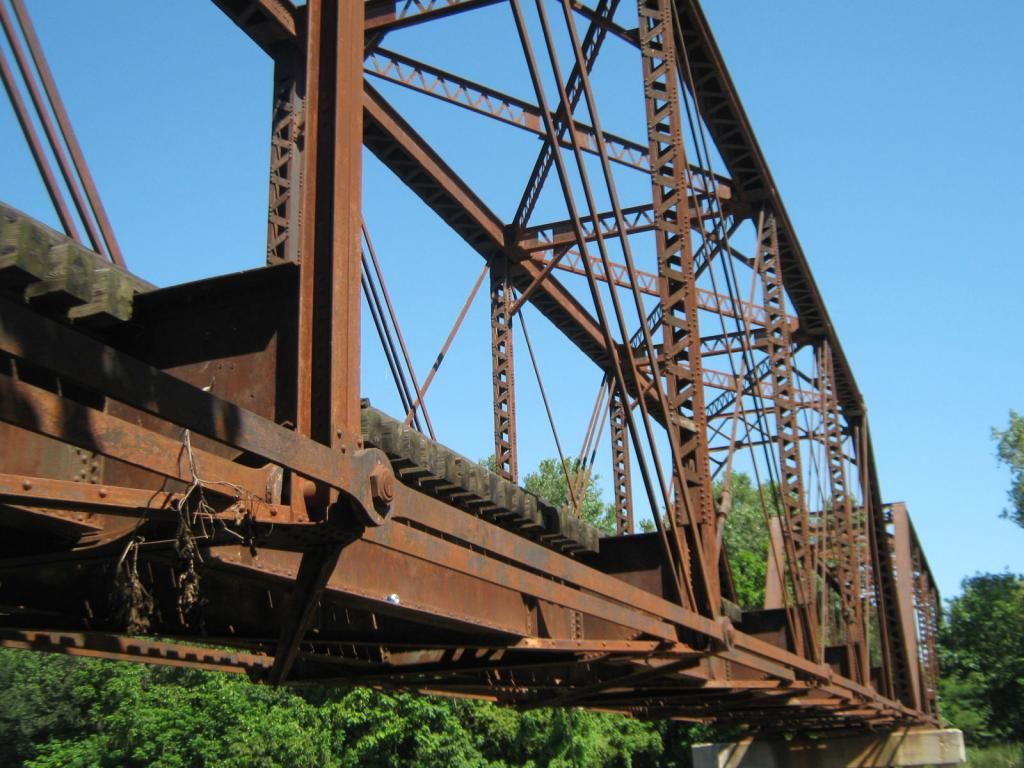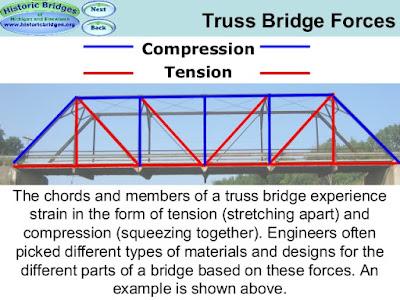|
|
Post by wabash2800 on Mar 26, 2021 12:37:24 GMT -8
Tim: The bridge you have pictured is a pin connected bridge, not one with cables. See my original post reference pin connected bridges. Victor, I'm intrigued by your statement of the Central Valley bridge being too light. I'll attach photos of a pin truss bridge that SD40T-2s with grain trains use regularly and the Central Valley bridge appears to be a heavier bridge than that. What is wrong with the Central Valley bridge and how can it be changed to be structurally sound? Like their single track bridge, on the prototype, it's too light for anything bigger than a GE 44 Tonner or a small 2-8-0, but I suppose most modelers won't know that or care. I'm going to use the double-track one as a highway bridge.
Victor A. Baird www.erstwhilepublications.com
[/quote]   [/quote] |
|
|
|
Post by unittrain on Mar 26, 2021 13:28:37 GMT -8
|
|
|
|
Post by edwardsutorik on Mar 26, 2021 13:43:28 GMT -8
As I mentioned about seven years ago, in this very topic, bridges that look very light can handle some big loads. Here's a now-removed (pin connected) bridge on the SP&S: pix-park.com/SP&Sbridge.jpgThat bridge handled Z-8 Challengers, C-636's, and trains of 100 ton Bethgons. And the trains did NOT creep over at slow speeds. Ed |
|
|
|
Post by bridge2nowhere on Mar 26, 2021 14:09:15 GMT -8
Nice bridge. Any closeup pictures of the changes? |
|
|
|
Post by bridge2nowhere on Mar 26, 2021 14:25:51 GMT -8
Wow, those piles sure ruined the simplifying calculations. Ed
I'm not going argue with you there. The strengthening of the bridge was done sometime after the bridge was originally built. I wonder if even the original designer/bridge company was consulted during the modifications [probably not].
James Bilbrey
LaVergne, TN Since we're already discussing a 7 year old thread, I'll comment on this. In this case, it's likely the piles take all the load, so it's really simple calculations. The truss is just along for the ride at this point. There is no need to discuss with anyone else, as the railroads have bridge engineers (internal or consultants) who can easily design this, it was probably a railroad design anyway, and the original designers were likely long gone. |
|
|
|
Post by bridge2nowhere on Mar 26, 2021 14:44:10 GMT -8
While they simplified the construction of older truss bridges, pin-connections served another purpose. They greatly simplified the calculations for the engineer that was analyzing the stress that the different members were going to be subjected to by live and dead loads. I suggest that they did not simplify the calculations at all. But they did guarantee that if there was a compressive load on one of the tension members, the bridge would fail. Well, not if it were, like, 20 pounds. But, hey, designer is supposed to be an engineer. You cannot simply insert a tension bar anywhere in a truss diagram, and arbitrarily decree the loads are tension. It goes the other way. You MAY insert a tension member where the calculations decree it. In fact, it WILL be a tension member, but it can be fabricated in various manners. And, yes, I have done truss bridge load calculations. Ed You have it backwards. Pinned connections were used originally to make hand calculations practical. Later on it was found that a riveted connection could be analyzed similarly despite the theoretical analytical complications of a rigid connection. After that stronger riveted connections became the norm. Pure tension members were often eyebars or rods on these older pinned trusses. Since the diagonals on a railroad truss see both tension and compression, they are generally either a built up member with some compressive strength and/or paired with a counter in the same panel that would take the load in tension. These are the members that are too light on the CV truss. While many pinned trusses are still in service, that particular prototype is much lighter in construction than the other examples shown on this old thread Probably not 44 tonner light, but lighter. |
|
|
|
Post by edwardsutorik on Mar 26, 2021 15:25:08 GMT -8
Since the diagonals on a railroad truss see both tension and compression... I think not. Here is a very nice graphic showing the elements of a Pratt truss. Note that some elements are in tension. And some are in compression. But none are noted as experiencing both, as you asserted:  You will notice in my sample picture, pix-park.com/SP&Sbridge.jpgthat there are some diagonals made of approximately 1" steel rod. Steel rods (and steel cable) are invariably used as tension-only members, because the exhibit comparatively little strength in compression. These are clearly tension-only members. On the other hand, the diagonals on the ends are experience only compression. Note also the glorious pictures posted by Mr. Baird, of that beautiful delicate bridge. ALL the internal diagonals are tension members. They are steel rods, and exceptionally inefficient at taking compressive loads. ALL of the bottom chord members are tension members. They too are steel rods, and are inefficient at taking compressive loads. The internal verticals are ALL compression members. Note that they are shaped differently. Their cross-sectional dimensions are much large than the rods just mentioned. This is to lessen the chance of buckling sideways when compressively loaded. Ed |
|
|
|
Post by bridge2nowhere on Mar 26, 2021 15:47:43 GMT -8
I think not. Here is a very nice graphic showing the elements of a Pratt truss. Note that some elements are in tension. And some are in compression. But none are noted as experiencing both, as you asserted:  You will notice in my sample picture, pix-park.com/SP&Sbridge.jpgthat there are some diagonals made of approximately 1" steel rod. Steel rods (and steel cable) are invariably used as tension-only members, because the exhibit comparatively little strength in compression. These are clearly tension-only members. On the other hand, the diagonals on the ends are experience only compression. Ed You think wrong. Your diagram is nice for a static load, but a moving load, such as a train, will cause both tension and compression in every diagonal (and most vertical posts) as it crosses the bridge, (obviously not at the same time, but they will see both). Consider the first axle on and the last axle off the bridge. Any tension only diagonal will need to be countered by one in the opposite direction, or is not a true tension only member. This is clear in the pictures posted by both you and Mr. Baird. You are correct that the end posts don't see tension, but they aren't generally considered diagonals either. You also won't likely see steel cable used regularly outside of an emergency. Steel rod are used only for the lightest members or counters. The bottom chord members are large forged eyebars. These are larger due to the larger capacity required in the bottom chord, where there is only tension. They are still poor in compression. |
|
|
|
Post by edwardsutorik on Mar 26, 2021 16:24:13 GMT -8
The bottom cord members are large forged eyebars. Also poor for tension. Eyebars are poor for tension? At exactly the places where they would be USED in tension? Well then, they must be good for something. And in a bridge, only compression is left. Because if they're poor in tension and poor in compression, they're just useless in a truss. So rectangular steel bars are good in compression. There are a lot of people who don't know that. Ed |
|
|
|
Post by bridge2nowhere on Mar 26, 2021 16:55:21 GMT -8
The bottom cord members are large forged eyebars. Also poor for tension. Eyebars are poor for tension? At exactly the places where they would be USED in tension? Well then, they must be good for something. And in a bridge, only compression is left. Because if they're poor in tension and poor in compression, they're just useless in a truss. So rectangular steel bars are good in compression. There are a lot of people who don't know that. Ed Obvious mistype on my part. Which I corrected well before your post. |
|